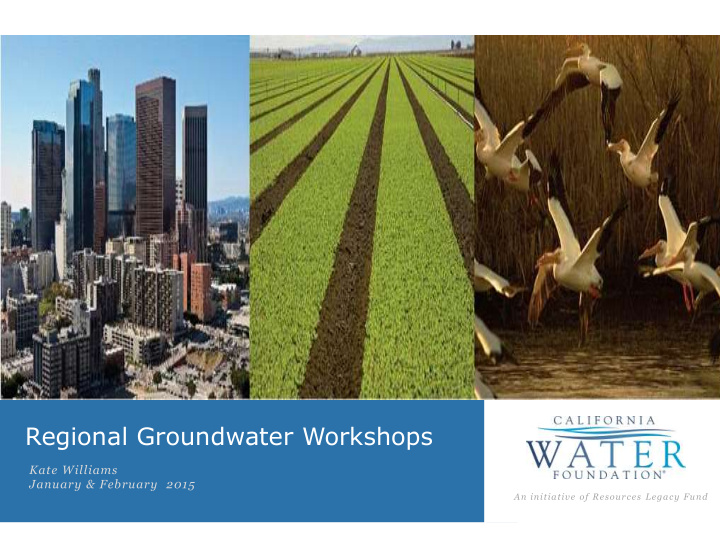



Custom Layout Regional Groundwater Workshops Kate Williams January & February 2015 An initiative of Resources Legacy Fund
Overview CWF – Who we are Overview of SGMA Steps to Forming a GSA Governance Models
California Water Foundation Advance change: To make our cities, farms • Remove barriers and environment, • Promote new policies & sustainable and resilient approaches
Custom Layout 2014: Year of Water Historic Drought Governor’s Water Action Plan Historic Groundwater Legislation Passage of Proposition 1
Custom Layout SGMA Overview Sustainable Groundwater Management Act (SGMA) Comprehensive legislation to manage groundwater to sustainable levels Tools/authorities to manage groundwater High and Medium Priority Basins Formation of a GS Agency Preparation of GS Plan Basin conditions & water budget Measurable objectives & 5 yr milestones Achieve sustainability in 20 years
Custom Layout SGMA Overview Sustainable Groundwater Management Act Retains local government authorities Promotes coordination between land use plans and groundwater plans Counties are presumed GSA, if no other identified
Custom Layout SGMA Overview Sustainability : Manage groundwater to prevent undesirable results (significant & unreasonable): Chronic lowering of groundwater levels Reduction of groundwater storage Seawater intrusion Degraded water quality / contaminant plume migration Land subsidence Depletions of interconnected surface water
Custom Layout SGMA Overview Sustainable Groundwater Management Act (SGMA) Local management with state oversight State Role (Carrot & Stick) Technical & Financial Assistance Regulations Review GSPs and monitor implementation Intervention if locals do not act
SGMA - Time Frame for Success Time Action 6/30/2017 Formation of GSAs 1/31/2020 Completion of GSPs in critically overdrafted basins 1/31/2022 Completion of GSPs in all other basins 1/31/2025 Intervention delayed 2 yrs in areas with significant impacts to surface waters 20-year Implementation of local GSPs to achieve implementation sustainability period
SGMA Overview -- Intervention If all or part of basin does not meet deadline Probationary status for that portion Public hearing and 180 days (6 months) After 180 days Groundwater extraction reporting Interim Plan developed by SWRCB Additional time if impacts to surface waters
Key Governance Features of SGMA Who can be a GSA Local determination GSA Exemptions: Alternative for functional equivalents Adjudicated basins Special Act Districts Engaging Interested Parties
Key Governance Features of SGMA Final GSA notification to DWR June 30, 2017 Public hearing and notice required prior to DWR notification Notice of Intent to DWR includes: Boundaries List of other GSAs Copy of resolution or bylaws List of interested parties & process of engagement 90 day period after notification to identify conflicts
6 Steps to Forming a GSA 1 . Identify your basins 2. Identify and work with local agencies 3. Understand your basin and available resources 4. Identify and involve interested stakeholders 5. Evaluate SGMA authorities & who wants to do what 6. Evaluate and propose governance model
1. Identify the Groundwater Basins Identify the high & medium priority basins in your region Identify basins that may be exempt Boundary issues that limit sustainable management SGMA basin focus is significant shift DWR CASGEM information www.water.ca.gov/groundwater/casgem/prioritymap.cfm
CASGEM Basin Prioritization Custom Layout
2. Identify & Work with Local Agencies Identify & map eligible local agencies Understand overlapping jurisdictions Identify County-only areas Understand local agency resources & knowledge Identify local agency interests – Regional water management - Role in GSA
2. Identify & Work with Local Agencies
2. Identify & Work with Local Agencies
3. Understand the Basin Collect and share basin information Existing plans, models, monitoring data, etc. Identify key hydrogeological issues in the basin Local, state, academic resources & expertise Should alternative process be pursued?
Potential Issues in Your Basin Declining elevations Subsidence and infrastructure impact Seawater intrusion Impacts to surface water systems Contaminant plumes Increased drilling/pumping costs Shallow wells threatened
4. Engage Interested Parties How will interested parties participate? GSA formation, plan development & implementation Identify and maintain list of interested parties What existing advisory groups can be used? What level of engagement? Inform Consult Collaborate
5. Evaluate tasks and local interest Form follows Function Range of authorities & tasks Coordination Public outreach & stakeholder engagement Planning (GSP) Monitoring and Reporting Implementation Enforcement Assess existing local agency interest
Custom Layout 6. Evaluate Governance Models Centralized GSA Distributed GSAs Combination 23
Centralized GSA Single GSA Covers entire basin Assumes all authorities and responsibilities New or existing agency Board can include existing agencies/interests Likely legal structure – JPA, Special District, County, Water District
Distributed GSA Coordination Agreement/MOU Single County City Multiple Water Dist. GSA GSA Agency GSA GSA Each GSA assumes all responsibilities for it’s service area Coordination Agreement required if multiple GSPs MOU/agreement can support coordination of tasks Likely legal structures -new or existing agency: County, City, Water District, JPA, Special Dist.
Combination GSA County Multiple GSA Agency GSA Centralized GSA Single City Water Dist. GSA GSA Centralized GSA: assumes some shared responsibilities Multiple GSAs: assume remaining responsibilities Likely legal structures, new or existing: County, City, Water District, JPA, Special Dist.
Next Steps for GSA Initiate dialogue with other local agencies Engage interested parties Gather information about the basin Consider third party facilitator Learn from others!
Recommend
More recommend